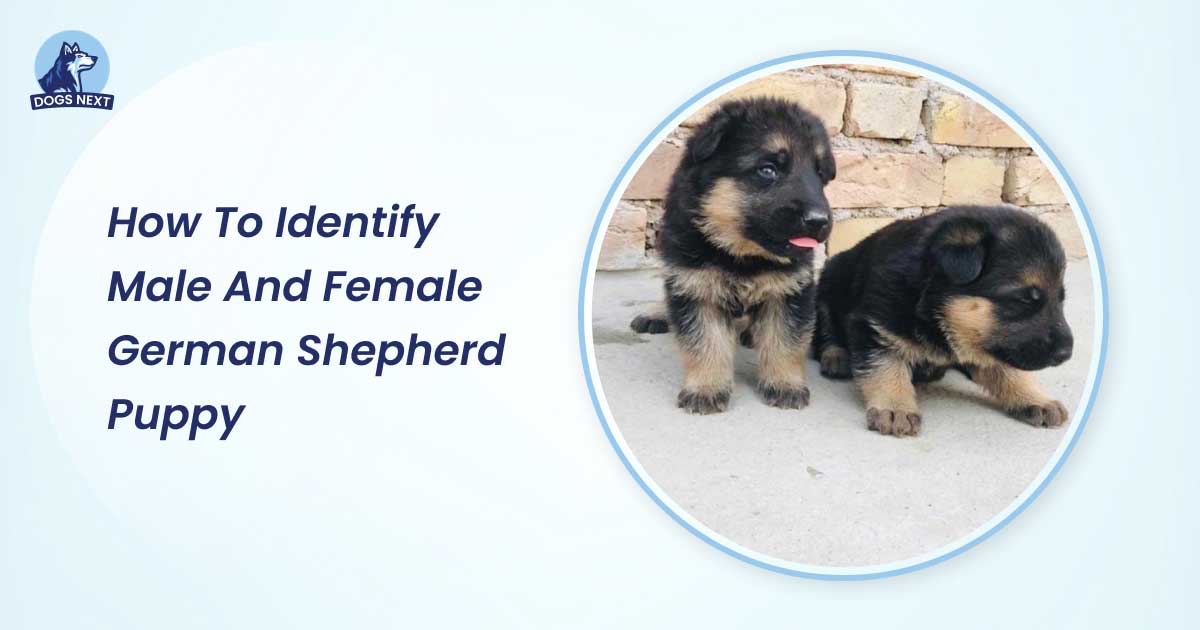To identify male and female German Shepherd puppies, observe their physical traits and behavior. Males typically have larger frames and more pronounced features than females.
German Shepherds are one of the most popular dog breeds worldwide, known for their intelligence and loyalty. As a prospective owner, distinguishing between male and female puppies is crucial for your decision-making. Each gender has unique characteristics that may influence your choice.
Males often exhibit a more robust build and can be more dominant, while females tend to be smaller and may display more nurturing behaviors. Understanding these differences helps ensure a harmonious fit for your lifestyle and family. This guide will outline key indicators to help you accurately identify the gender of German Shepherd puppies.
Physical Differences Between Male And Female Puppies
Identifying male and female German Shepherd puppies can be tricky. Their physical differences are subtle yet significant. Understanding these differences helps in choosing the right puppy for your home. This guide will focus on the main physical traits that distinguish male and female German Shepherd puppies.
Size And Build
One of the most noticeable differences between male and female German Shepherd puppies is their size and build. Males are generally larger and more muscular than females. Here are some key points:
- Males: Typically weigh between 65-90 pounds.
- Females: Usually weigh between 50-70 pounds.
- Males: Stand about 24-26 inches tall at the shoulder.
- Females: Measure around 22-24 inches tall at the shoulder.
The following table summarizes these physical characteristics:
| Gender | Weight (lbs) | Height (inches) |
| Male | 65-90 | 24-26 |
| Female | 50-70 | 22-24 |
Males often have a broader chest and thicker neck. This gives them a more robust appearance. Females appear more graceful and have a slimmer build. This difference in size and build is important for potential owners to consider.
Subtle Differences In Facial Features And Paws
Facial features and paws also show differences between male and female German Shepherd puppies. These distinctions may be subtle but are worth noting:
- Males: Have a more pronounced jawline and larger heads.
- Females: Typically have a softer, more rounded face.
- Paws: Male puppies generally have larger paws.
- Paws: Female puppies have smaller, more delicate paws.
Here are the notable facial features in a simple comparison:
| Feature | Male | Female |
| Jawline | Pronounced | Softer |
| Head Size | Larger | Smaller |
| Paw Size | Larger | Smaller |
These differences help in identifying the gender of German Shepherd puppies. Observing the facial features and paw sizes can provide clear hints about whether the puppy is male or female. Understanding these traits enhances the experience of choosing a puppy.
Behavioral Traits In Male Vs Female Puppies
Identifying male and female German Shepherd puppies involves more than just physical traits. Behavioral traits play a big role too. Males and females exhibit different behaviors that can help you determine their gender. Understanding these traits helps you choose the right puppy for your home. Let’s explore how males and females behave differently.
Dominance And Energy Levels In Males
Male German Shepherd puppies often show higher energy levels. They tend to be more active and playful. This energy can lead to behaviors like:
- Rough play: Males may engage in more intense play.
- Chasing: They love to chase after balls and toys.
- Exploration: Males often explore their surroundings more.
These behaviors indicate their higher energy levels. Males can also display:
| Behavior | Description |
| Dominance | Males may try to assert themselves in play or social situations. |
| Protectiveness | They can be more protective of their territory. |
Training male puppies may require more effort. Consistent training helps manage their dominant behaviors. Regular exercise also keeps them balanced. Engage them with activities like:
- Agility courses
- Fetch games
- Daily walks
Understanding these traits aids in nurturing their energy positively.
Affectionate And Nurturing Traits In Females
Female German Shepherd puppies often show more nurturing and affectionate behaviors. They tend to bond closely with their owners. This bond can be seen through:
- Gentle play: Females may play more gently compared to males.
- Cuddling: They enjoy snuggling and being close to people.
- Empathy: Females can sense their owner’s emotions easily.
These nurturing traits make them great companions. Female puppies also exhibit behaviors like:
| Behavior | Description |
| Motherly instincts | They may care for toys like they are puppies. |
| Calmness | Females often remain calm in new situations. |
Training female puppies is often easier due to their desire to please. Use positive reinforcement methods like:
- Reward treats
- Praise
- Playtime
These methods help build a strong bond. Understanding these traits helps in raising a well-adjusted puppy.
Observing Genitalia For Gender Identification
Identifying the gender of German Shepherd puppies is important for future care and training. One reliable method is by observing the genitalia. This method helps you distinguish between male and female puppies easily. Understanding the differences can aid in choosing the right puppy for your family.
Male And Female Puppies
Male and female German Shepherd puppies exhibit clear differences in their genitalia. Recognizing these differences is essential for proper identification. Here are some key points to remember:
- Male Puppies:
- Have a visible penis and testicles.
- Testicles may not be fully descended in young puppies.
- Size is generally larger than females.
- Female Puppies:
- Have a vulva, which appears as a small slit.
- Look smaller in size compared to males.
- Do not have testicles.
Here’s a simple table summarizing the differences:
| Feature | Male Puppies | Female Puppies |
| Genitalia | Visible penis and testicles | Vulva (small slit) |
| Size | Larger | Smaller |
| Behavior | More territorial | More nurturing |
To identify gender accurately, carefully examine the area under the tail. Gently lift the tail to get a clear view. This method works best when puppies are calm. Remember, patience is key.
Identifying the gender of German Shepherd puppies is a rewarding experience. Knowing the differences helps you prepare for their unique needs. Whether you choose a male or female, understanding these traits ensures a loving home.
Long-term Differences In Training And Temperament
Identifying male and female German Shepherd puppies involves more than just physical traits. Long-term differences in training and temperament play a crucial role. Knowing these differences helps in choosing the right puppy for your lifestyle. Understanding how males and females adapt can lead to a happier home.
Male Vs Female Adaptability
When it comes to adaptability, male and female German Shepherds show distinct behaviors. Understanding these differences can help you train them effectively.
Male German Shepherds tend to be:
- More independent: They may require more time to bond.
- Stubborn: Training might take a bit longer.
- Playful: They often enjoy rough play and physical activities.
Female German Shepherds generally exhibit:
- Strong bonding: They usually attach closely to their owners.
- Focus: Females often concentrate better during training.
- Calmness: They may show a more relaxed demeanor.
| Traits | Male German Shepherds | Female German Shepherds |
| Independence | Higher | Lower |
| Training Ease | More challenging | Easier |
| Playfulness | Very playful | Moderately playful |
| Bonding | Less intense | More intense |
These traits influence training methods. Males may need more patience and consistent correction. Females usually respond well to praise and rewards. Tailoring your approach will create a more effective training experience.
Choosing between a male or female German Shepherd can affect your training journey. Each gender has unique traits that influence their adaptability. Understanding these differences can lead to a more harmonious relationship with your new puppy.
Frequently Asked Questions
How Can I Tell If My German Shepherd Is Male Or Female?
To determine your German Shepherd’s gender, check physical traits. Males are generally larger with more muscular builds. They also have a broader head and larger paws. Females tend to be smaller and more slender. Look for subtle differences in body shape and size to help identify the gender.
What Are The Physical Differences Between Male And Female Puppies?
Male German Shepherd puppies usually have a thicker neck and broader chest. They also display a more pronounced jawline. In contrast, female puppies are typically lighter and more agile. Their features are generally more refined, making it easier to distinguish between genders as they grow.
Do Male And Female German Shepherds Behave Differently?
Yes, male and female German Shepherds can exhibit different behaviors. Males may be more territorial and protective, while females often display nurturing qualities. Socialization and training also play a significant role in behavior. Understanding these tendencies can help you manage their training and interactions better.
At What Age Can I Identify My German Shepherd’s Gender?
You can usually identify a German Shepherd’s gender by 6 weeks of age. By this time, physical differences become more apparent. However, subtle traits may still evolve as they grow. Observing their behavior and physical characteristics will help confirm their gender over time.
Conclusion
Identifying male and female German Shepherd puppies is essential for prospective owners. By observing physical traits and behavioral differences, you can make an informed choice. Understanding these characteristics helps in raising a balanced and happy dog. Use this knowledge to find the perfect companion for your family and lifestyle.

I’m David, an expert contributor and writer, with two furry friends of my own, I know the challenges of raising and caring for dogs. From training to nutrition and health, my goal is to provide valuable insights and advice to help create strong bonds and happy, healthy lives. Find me in Twitter.




